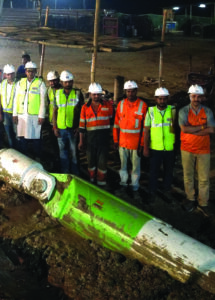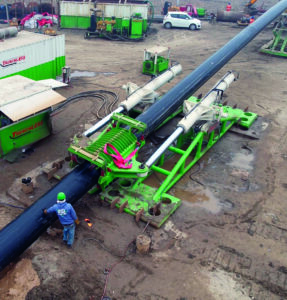Article originally featured in Trenchless Australasia
World Record Dual HDD Intersects in India
 Numaligarh Refinery Limited (NRL) is in the process of laying a 1635km cross country pipeline from Paradip Port in Odisha to their refinery Numaligarh, Assam, India. The pipeline is proposed to run from Paradip port, crossing through five states before terminating at the Numaligarh refinery in Assam. The 26” pipeline will enable the expansion of the refinery from 3.0 million tons per annum to 9.0 million tons per annum as part of ‘Numaligarh Refinery Expansion Project (NREP)’.
Numaligarh Refinery Limited (NRL) is in the process of laying a 1635km cross country pipeline from Paradip Port in Odisha to their refinery Numaligarh, Assam, India. The pipeline is proposed to run from Paradip port, crossing through five states before terminating at the Numaligarh refinery in Assam. The 26” pipeline will enable the expansion of the refinery from 3.0 million tons per annum to 9.0 million tons per annum as part of ‘Numaligarh Refinery Expansion Project (NREP)’.
The pipeline route crosses all the major rivers in Eastern India including the Ganga, Jia Bharali, Subansiri, and Brahmaputra via Horizontal Directional Drilling (HDD). The longest of those crossings under the Ganga River was awarded to M/S Trenchless Engineering Services Pvt Ltd.
Completing this dual 4027m crossing was a technical achievement made more difficult by the location as well as a narrow weather window in which they needed to complete the crossing. “Since the location was prone to floods, we had a very small window to enter and execute,” says Vipin Gupta, Managing Director, Trenchless Engineering Services Pvt Ltd. Further, the location was 9km off the blacktop road into a remote village, and the road distance between the rig side and the pipe side was a challenging 200 km with poor road conditions, often taking trailers up to 16 hours for a single trip. As a result, the work was performed in the dry season from January to May. The first pilot was commenced on 25 of January 2024 using two American Augers DD1100 rigs. The DD1100 is one of the largest rigs in the American Augers lineup with 500 metric tons of push/pull capacity.
Despite the immense rig power available, the crossings were designed to use the Intersect method rather than as a single push from entry to exit. Intersecting at a specific point in HDD is a technique often used for long or complex bore paths, especially when dealing with installations that exceed typical drilling lengths of 2000+ meters.
The Intersect method provides several benefits including:
Increased Accuracy: Intersecting allows for greater control and accuracy in the drilling process. By planning to meet at a designated midpoint or specific location, the drill path can be managed more precisely from both ends, which is crucial in long bores to ensure the paths meet accurately.
Reduced Risk: Drilling from both ends towards a midpoint can help mitigate risks associated with long horizontal drills such as excessive torque, drag, and pipe sticking. It also allows for better management of potential issues like fluid pressures and borehole stability, since adjustments can be made from either end if problems are detected.
 Equipment Limitations: HDD rigs have limitations in terms of the length of the drill pipe they can push or pull due to friction and the power of the rig. By intersecting from two sides, each rig only needs to cover half the distance, making very long crossings feasible without exceeding the capabilities of the drilling equipment.
Equipment Limitations: HDD rigs have limitations in terms of the length of the drill pipe they can push or pull due to friction and the power of the rig. By intersecting from two sides, each rig only needs to cover half the distance, making very long crossings feasible without exceeding the capabilities of the drilling equipment.
Geotechnical Considerations: The presence of cobbles, boulders, and other difficult geologies may limit the feasibility of HDD. The Intersect method enables the driving of conductor casing near surface while traversing these zones, then Intersecting during a tangent section to complete the pilot bore.
For the Ganga River crossing, Trenchless Engineering Services was tasked with installing two separate pipelines within a narrow 18m right of way. Both a primary 26” gas line as well as a parallel 6” accessory line was to be installed via the HDD Intersect method with just 6m separation.
To guide them across such a complicated crossing, Trenchless Engineering Services chose the ParaTrack HDD Guidance System. ParaTrack offers the trenchless industry’s widest range of guidance technology, allowing contractors to confidently complete installations of any size.
From that expansive guidance toolkit, Trenchless Engineering Services selected the ParaTrack Steering Tool, supplemented by P2 AC Magnetic Guidance, a Pressure Module and Magnetic Intersect technology.
As the crossing was scheduled during the dry season, river levels were at their lowest, and the surface was accessible for all but 1000m of the right of way. This allowed for the installation of a series of P2 AC Magnetic Guidance coils which were used to verify the surveyed position calculated by the Steering Tool. The Intersects were planned to take place after crossing the Ganga River from the Paradeep side, utilizing P2 AC Magnetic Guidance to provide the accuracy required to connect the pilot bores. As each rig’s guidance system references the same external control point, the Intersect can be performed quickly and reliably, without the need for specialized (and costly) intersect equipment.
After the successful intersection, the 12 ½” pilot was reamed in 3 stages to 20”, 30” and 38” for the final pass. “The crucial thing was to maintain returns up to 4km, so that cutting flow was maintained,” says Gupta. “Our engineering team designed special reamers for dual-sided pumping, easing the mud purging process and handling the loads efficiently. Using two 600 GPM pumps in tandem for reaming, achieving a flow rate of nearly 800 GPM, was crucial in speeding up the drilling process and managing the cuttings. Torque was limited to 80 KNm and the 26” pipeline was successfully pulled in on 12 April 2024, ahead of schedule, and a world record for the distance at just 76 days.”
With the success of this HDD, NRL is now focused on completing the remaining HDDs over the next several months, thereby completing all major HDD crossings of its 1635km long Paradip Numaligarh Crude Oil Pipeline (PNCPL). NRL plans to accomplish construction and commissioning of the PNCPL Project by Mid-2025.



